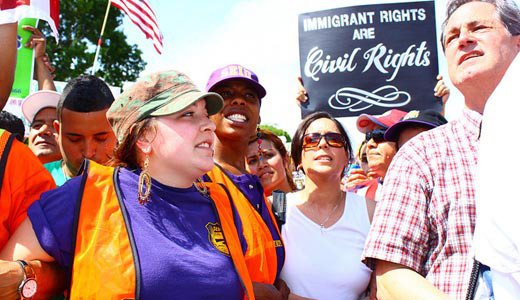
Opponents of comprehensive immigration reform, or even the far milder DREAM Act, demand an “enforcement first” approach to immigration. They argue that the U.S. should first fix what they see as porous borders and step up a fight against illegal immigration. Only then, they argue, should immigration reform be enacted.
However, they are wrong on the facts, according to a new report issued yesterday by the Migration Policy Institute. The United States already spends more money on and has more infrastructure devoted to stopping undocumented immigrants from entering the country than for any other activity designated as illegal. Advocates of harsh anti-immigrant policies have, by and large, gotten their way over the past quarter century as the U.S. has slowly built up “a complex cross-agency system that is interconnected in an unprecedented fashion,” in the words of the report. The report is titled “Immigration Enforcement in the United States: The Rise of a Formidable Machinery.”
This system has six main pillars, according to the report: border enforcement, visa controls, enhanced data systems and sharing, workplace enforcement (such as with the notorious e-Verify system), “the intersection of the criminal justice system and immigration enforcement,” and deportation.
According to Donna Kerwin, a co-author of the report, “The facts on the ground … challenge long-held public skepticism over the federal government’s will and ability to enforce the nation’s immigration laws.”
Even the notion of the “illegal” immigrant is relatively new. While border controls have been in place for centuries, undocumented immigration only began to be seen as a truly criminal activity after the passage of the 1986 Immigration Reform and Control Act.
While the 1986 law gave amnesty (with the approval of then President Ronald Reagan) to millions of undocumented immigrants, it for the first time made it illegal to hire an undocumented immigrant. Additionally, it called for increased border enforcement. This last provision of the 1986 law, the MPI report says, touched off the piecemeal creation of the now sprawling immigration enforcement system.
This de facto “enforcement first” policy has been instituted piece by piece since 1986, MPI found. In fact, so much has effort has been put into stemming the flow of undocumented immigrants, mostly from Mexico and Central America, that the budget for immigration enforcement policies is more than the combined budgets of the FBI, the Drug Enforcement Agency, the Secret Service, the U.S. Marshals Service and the Bureau of Alcohol, Tobacco and Firearms. Further, immigration agencies send more cases to court than all Department of Justice law enforcement agencies.
Each year, more than 430,000 undocumented immigrants have been detained. That is more than the entire population of the federal prison system.
Likely because of this, fewer people are crossing the border than ever, despite grinding poverty in Mexico and Central America. Despite the enforcement infrastructure, the number of people apprehended at the U.S.-Mexico border was at a 40-year low in 2011.
For the American taxpayer, the costs are high. In 2012, the anti-immigrant machinery cost the U.S. nearly $18 billion, compared to $14.4 billion for all other federal law enforcement agencies.
For the undocumented, the statistics are horrifying: Since 1990, more than 4 million people have been deported, and deportations are now at a record high. In 1990, only about 30,000 people were deported; the corresponding figure for 2011 was nearly 400,000. This has created for the undocumented an atmosphere of terror, as sweeps by immigration authorities have broken apart families and devastated entire communities.
MPI Senior Fellow and former Immigration and Naturalization Service Commissioner Doris Meissner said, “Changes to the immigration system over recent decades have focused almost entirely on building enforcement programs and improving their performance. Yet even with record-setting expenditures and the full use of statutory and administrative tools, enforcement alone, no matter how well administered, is insufficient to answer the broad challenges that immigration poses for America’s future.”
After decades of immigration enforcement policies, public attitudes have begun to change. President Barack Obama in 2012 ordered the Department of Homeland Security to enact a program – Deferred Action for Childhood Arrivals – that would at least temporarily halt deportations of undocumented immigrants who arrived here as children. In addition, the administration made a change, to take effect March 4, that will lift bans on returns to the U.S. for some of those already in deportation proceedings.
Latinos, who voted in 2012 in record numbers, as well as other immigrant groups and their allies in labor and other organizations, are planning to launch a nationwide fight for immigration reform. According to Obama administration officials, the president and Democrats have
The MPI’s Meissner underlined a key point that immigrant rights advocates make, saying, “Successive Congresses and administrations have accomplished what proponents of ‘enforcement first’ sought as a precondition for reform of the nation’s immigration policies.”
Now, immigrant rights advocates argue, it is time for the other side of reform.
Photo: At the May 1, 2010, march and rally for immigration reform, with the Trail of Dreams and Rep. Luis Gutierrez, in Washington, D.C. Justin Valas. CC BY ND NC 2.0










